Flow Characteristics and Energy Loss within the Static Impeller of Multiphase Pump
Abstract
:1. Introduction
2. Basic Theory and Governing Equation
2.1. Turbulence Model
2.2. The Governing Equation
2.3. Energy Loss Computational Methods
3. Simulation Model and Mesh Generation
3.1. Simulation Model
3.2. Mesh Generation and Verification of Irrelevance
4. Numerical Calculation Method and Solution Setting
5. Experimental Setup and Verification
5.1. Experimental Setup
5.2. Experimental Verification
6. Result Analysis
6.1. The Effects of Flow Rate on Velocity Vector in Static Impeller
6.2. Analysis of Energy Losses in Static Impeller of Multiphase Pump
6.3. Comparative Analysis of Energy Loss between Different Stages of Static Impeller
7. Conclusions
- (1).
- The flow within the impeller wheel is more uniform than the static impeller, and larger axial vortexes appear in the static impeller, and under the condition of low flow rate, the vortex in the static impeller of the multiphase pump almost cover the entire flow passage of the impeller, this is because at this condition, the constraint ability of the blade to the fluid is weak, and large vortices are prone to appear. However, with the increase of the flow rate, the vortex gradually decreases even basically disappear in individual flow passage. Compared with the impeller wheel, the effect of the flow rate on the flow within the first static impeller is greater.
- (2).
- The streamline distribution in the cross section of the impeller wheel of the multiphase pump is more uniform than that in the static impeller. At different flow rate, the flow in different areas of the first static impeller of the multiphase pump is relatively chaotic, and the size of the radial vortex gradually increases from the inlet to the outlet section. It can be seen that the flow in the first static impeller is more obviously affected by the flow change than that in the impeller wheel, and the flow in the static impeller is more complex.
- (3).
- At the different flow rate, the energy loss in the static impeller is mainly the turbulence dissipation loss and the friction loss, the inlet shock loss and the contraction loss accounted for less than 20%. With the increase of flow rate, the proportion of the inlet shock loss, the friction loss and the contraction loss in the static impeller increases gradually, and the proportion of the turbulence dissipation loss in the static impeller decreases gradually. The proportion of energy loss in the first and second static impellers has little difference under different flow rate, and both of them are about 50%, indicating that the position of the static impeller has little influence on the flow condition and energy loss in the static impeller.
- (4).
- It can be known from the analysis of the above, the energy loss in multiphase pumps is mainly caused by the change of the flow within the static impeller, and found that the changing rule of energy losses in the static impeller with different flow rate, the different level higher and so on. However, if we simply analyzed the source and the regularity, and did not put forward the solution, in the subsequent research, the performance can be optimized to improve the efficiency of the multiphase pump.
- (5).
- Because the vortex in the multiphase pump is mainly concentrated in the static impeller, this paper mainly studies the flow characteristics and energy loss in the static impeller, which has important guiding significance to reduce the vortex in the static impeller and improve the hydraulic efficiency of the multiphase pump.
Author Contributions
Funding
Institutional Review Board Statement
Informed Consent Statement
Data Availability Statement
Conflicts of Interest
Nomenclature
References
- Valizadeh, K.; Farahbakhsh, S.; Bateni, A.; Zargarian, A.; Davarpanah, A.; Alizadeh, A.; Zarei, M. A parametric study to simulate the non-Newtonian turbulent flow in spiral tubes. Energy Sci. Eng. 2020, 8, 134–149. [Google Scholar] [CrossRef] [Green Version]
- Shi, G.; Yan, D.; Liu, X.; Xiao, Y.; Shu, Z. Effect of the Gas Volume Fraction on the Pressure Load of the Multiphase Pump Blade. Processes 2021, 9, 650. [Google Scholar] [CrossRef]
- Yousefizadeh Dibazar, S.; Salehi, G.; Davarpanah, A. Comparison of Exergy and Advanced Exergy Analysis in Three Different Organic Rankine Cycles. Processes 2020, 8, 586. [Google Scholar] [CrossRef]
- Esfandi, S.; Baloochzadeh, S.; Asayesh, M.; Ehyaei, M.A.; Ahmadi, A.; Rabanian, A.A.; Das, B.; Costa, V.A.; Davarpanah, A. Energy, Exergy, Economic, and Exergoenvironmental Analyses of a Novel Hybrid System to Produce Electricity, Cooling, and Syngas. Energies 2020, 13, 6453. [Google Scholar] [CrossRef]
- Wang, C.; Zhang, Y.; Zhang, J.; Zhu, J. Flow pattern recognition inside a rotodynamic multiphase pump via developed entropy production diagnostic model. J. Pet. Sci. Eng. 2020, 194, 107467. [Google Scholar] [CrossRef]
- Fernández, J.; Marcos, A.; Barrio, R.; Blanco, E.; Parrondo, J. Studies of the flow of air in a mixed-flow pump using numerical simulations. Proc. Inst. Mech. Eng. Part A J. Power Energy 2011, 225, 647–654. [Google Scholar] [CrossRef]
- Bing, H.; Tan, L.; Cao, S.; Lu, L. Prediction method of impeller performance and analysis of loss mechanism for mixed-flow pump. Sci. China (Technol. Sci.) 2012, 55, 1988–1998. [Google Scholar] [CrossRef]
- Xu, Y.; Tan, L.; Liu, Y.; Hao, Y.; Zhu, B.; Cao, S. Pressure fluctuation and flow pattern of a mixed-flow pump under design and off-design conditions. Proc. Inst. Mech. Eng. Part C J. Mech. Eng. Sci. 2018, 232, 2430–2440. [Google Scholar] [CrossRef]
- Oh, H.W. Design parameter to improve the suction performance of mixed-flow pump impeller. Proc. Inst. Mech. Eng. Part A J. Power Energy 2010, 224, 881–887. [Google Scholar] [CrossRef]
- Yang, X.; Xia, Y.; Jin, L.; Cao, F. Experimental Study on Pumping Behavior of Twin-Screw Multiphase Pump. J. Xi’an Jiaotong Univ. 2013, 47, 30–35. [Google Scholar]
- Li, C.; Luo, X.; Feng, J.; Zhu, G.; Yan, S. Effect of Diversion Cavity Geometry on the Performance of Gas-Liquid Two-Phase Multiphase pump. Energies 2020, 13, 1882. [Google Scholar] [CrossRef]
- Li, C.; Luo, X.; Feng, J.; Sun, H.; Zhu, J.; Xue, G. Investigation on the influence of inlet gas volume fraction on the performance of deep-sea multiphase pump. Chin. J. Hydrodyn. 2020, 35, 248–257. [Google Scholar]
- Zhang, R.; Wang, S.; Osman Juma S A1. Transient Gas Liquid Flow in Helical Axial Pump Diffuser and Its DMD Analysis. Trans. Chin. Soc. Agric. Mach. 2020, 51, 118–126. [Google Scholar]
- Li, C.; Luo, X.; Feng, J.; Zhu, G.; Xue, Y. Effects of Gas-Volume Fractions on the External Characteristics and Pressure Fluctuation of a Multistage Multiphase pump. Appl. Sci. 2020, 10, 582. [Google Scholar] [CrossRef] [Green Version]
- Jinya, Z.; Shujie, C.; Hongwu, Z.; Ke, Y.; Rui, Q. Numerical Investigation of Compessible Flow in a Three-stage Helico-axial Multiphase Pump. Trans. Chin. Soc. Agric. Mach. 2014, 45, 89–95. [Google Scholar]
- Wang, Y. Study on design and selection of twin-screw multiphase pump for offshore platform. Pump Technol. 2017, 5, 24–27. [Google Scholar]
- Hu, Y.; Hu, C.C.; Zhang, J.; Qu, Z.C. Optimization Research on Structure of Synchronal Rotary Multiphase Pumps. Compress. Technol. 2016, 4, 16–21. [Google Scholar]
- Wang, K.; Hu, B.; Cao, F.; Wang, W.Y.; Li, Q.G.; Xing, Z.W. Leakage Analysis and Effect on Volumetric Efficiency of Twin-screw Multiphase Pump with Higher Gas Volume Fractions. Fluid Mach. 2011, 39, 10–16. [Google Scholar]
- Li, X.Q.; Wang, J.; Zhao, P.; Yu, G.C. A random fractal model of gas-liquid distribution in multiphase pump. J. Guangxi Univ. (Nat. Sci. Ed.) 2010, 35, 756–761. [Google Scholar]
- Zhang, J.; Cai, S.; Zhu, H. Visualization Test for Flow Field of Gas-liquid Two-phase in the Entrance of Rotodynamic Multiphase Pump. J. Mech. Eng. 2015, 51, 184–190. [Google Scholar] [CrossRef]
- Li, D.Y.; Gong, R.Z.; Wang, H.J.; Fu, W.W.; Wei, X.Z.; Liu, Z.S. Fluid flow analysis of drooping phenomena in pump mode for a given guide vane setting of a pump-turbine model. J. Zhejiang Univ. Sci. A (Appl. Phys. Eng.) 2015, 16, 851–863. [Google Scholar] [CrossRef] [Green Version]
- Minguan, Y.; Yu, M.; Bo, G.; Dan, N.; Zhong, L. Design of axial-flow impeller guide cone and simulation on hydraulic performance of its passage. Trans. Chin. Soc. Agric. Eng. 2015, 31, 81–88. [Google Scholar]
- Rennian, L.; Zhengjing, S.; Wei, H.; Hui, Q.; Qifei, L. Energy loss analysis of impeller flow of screw centrifugal pump. Trans. Chin. Soc. Agric. Mach. 2014, 45, 125–130. [Google Scholar]
- Jin, Y.; Zhang, D.; Shi, L.; Sheng, X.; Shi, W.; Wang, D. Numerical investigation of flow structure and energy loss in impeller side chamber of molten salt pump. Acta Energ. Sol. Sin. 2020, 41, 326–334. [Google Scholar]
- Shu, X.; Ren, Y.; Wu, D.; Zhu, Z.; Mou, J. Energy loss and unsteady flow characteristics in a self-priming pump. J. Hydraul. Eng. 2019, 50, 1010–1020. [Google Scholar]
- Shi, G.; Li, H.; Liu, Z.; Wang, S. Effect of Hub Ratio on Flow Field Characteristics in Multiphase Pump. Fluid Mach. 2020, 48, 49–54. [Google Scholar]
- Shi, G.; Wang, S.; Yao, X.; Li, H. Effect of cavitation on flow characteristics in multiphase pump. Water Resour. Power 2020, 38, 156–159. [Google Scholar]
- Shi, G.; Liu, Z.; Xiao, Y.; Wang, Z.; Luo, Y.; Luo, K. Energy conversion characteristics of multiphase pump impeller analyzed based on blade load spectra. Renew. Energy 2020, 157, 9–23. [Google Scholar] [CrossRef]
- Pei, J.; Osman, M.K.; Wang, W.; Yuan, J.; Yin, T.; Appiah, D. Unsteady flow characteristics and cavitation prediction in the double-suction centrifugal pump using a novel approach. Proc. Inst. Mech. Eng. Part A J. Power Energy 2020, 234, 283–299. [Google Scholar] [CrossRef]
- Pei, J.; Zhang, F.; Appiah, D.; Hu, B.; Yuan, S.; Chen, K.; Asomani, S.N. Performance prediction based on effects of wrapping angle of a side channel Pump. Energies 2019, 12, 139. [Google Scholar] [CrossRef] [Green Version]
- Suh, J.W.; Kim, J.W.; Choi, Y.S.; Kim, J.H.; Joo, W.G.; Lee, K.Y. Multi-objective optimization of the hydrodynamic performance of the second stage of a multi-phase pump. Energies 2017, 10, 1334. [Google Scholar] [CrossRef] [Green Version]
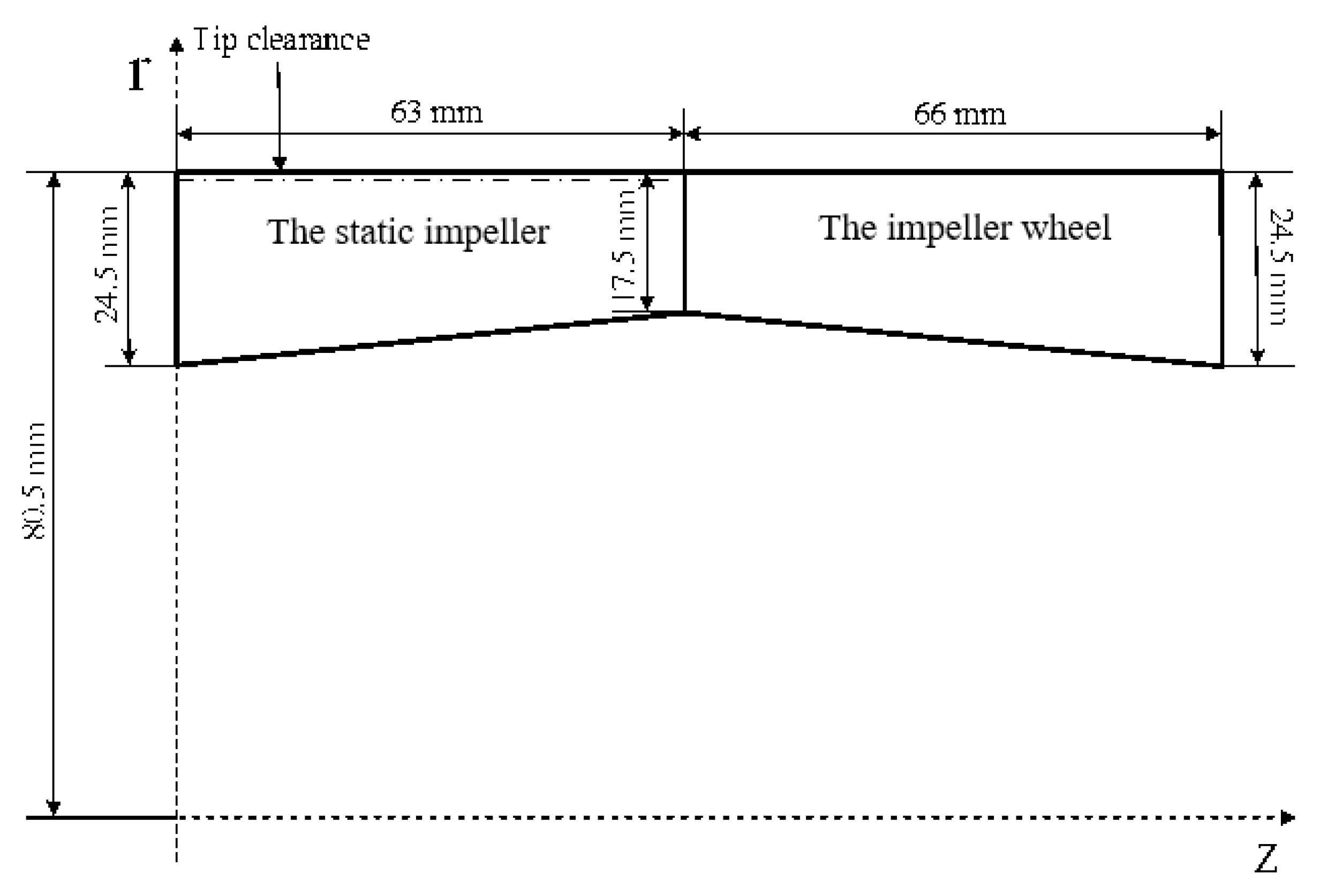
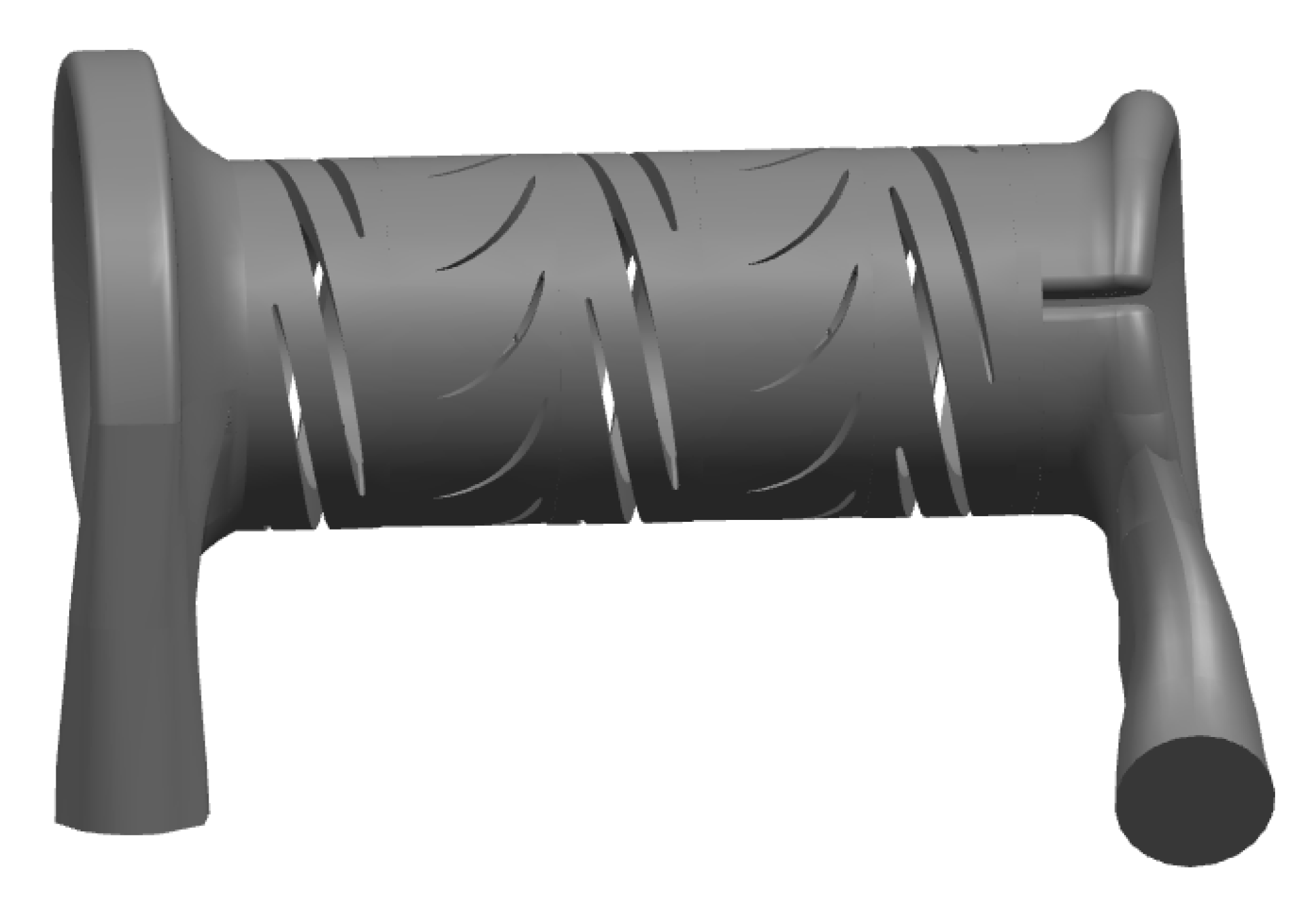
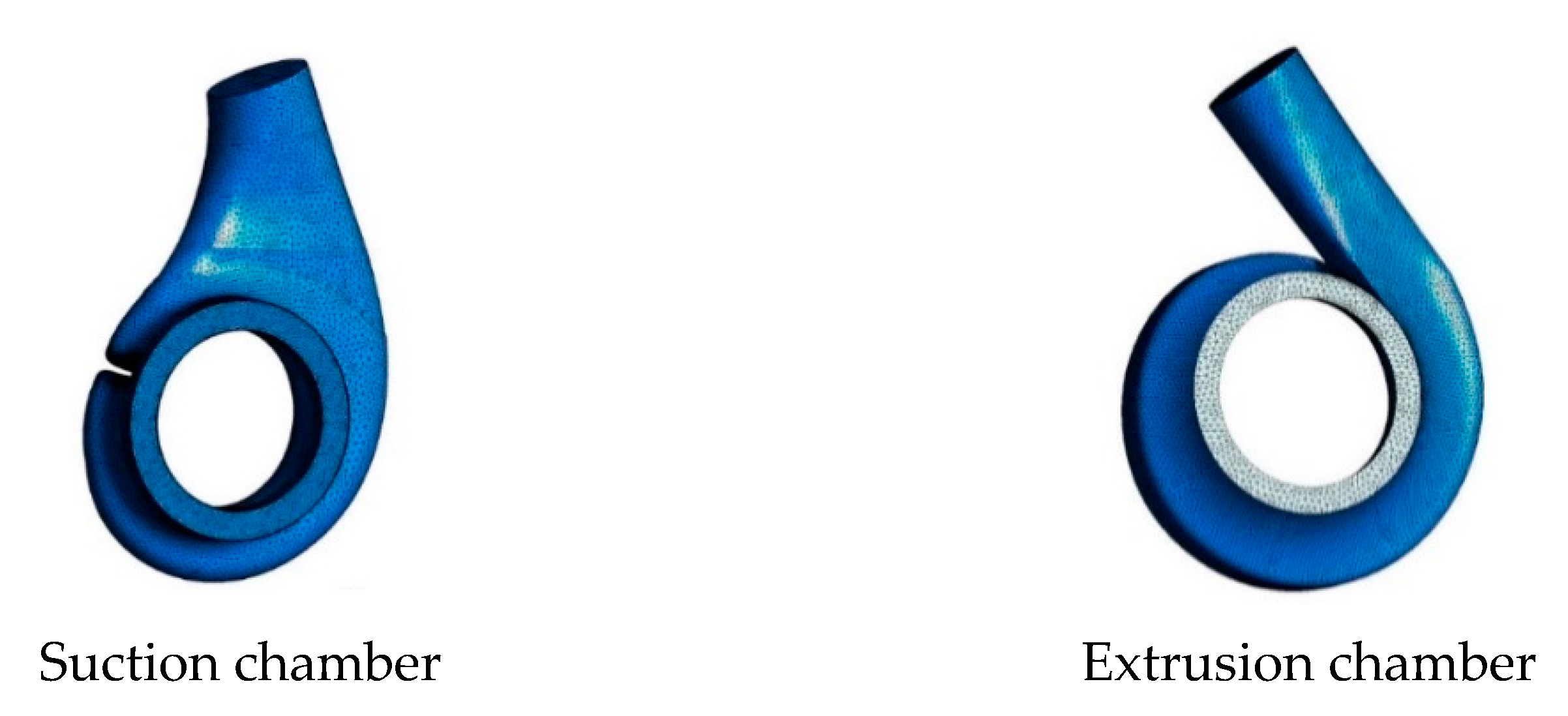

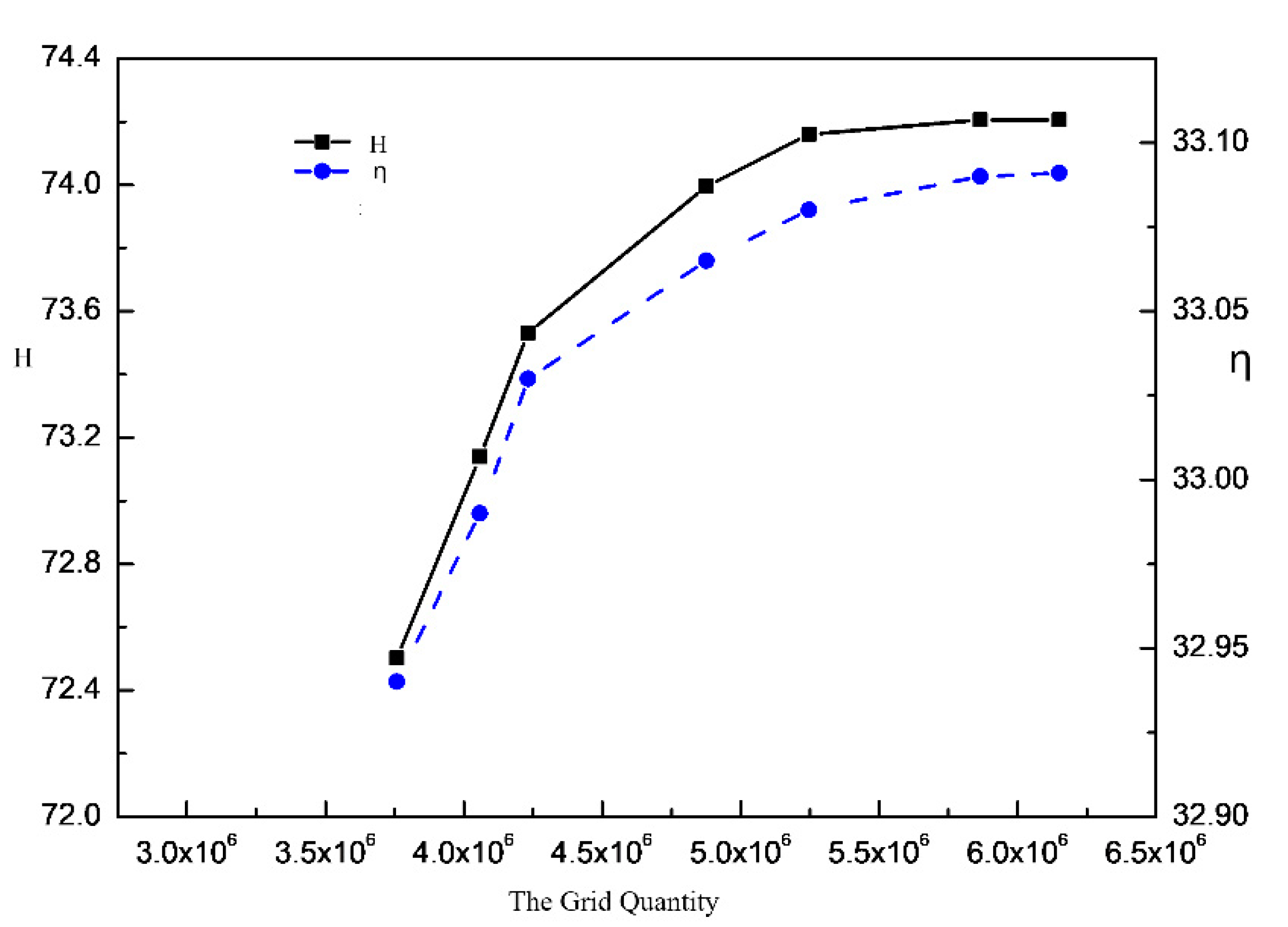
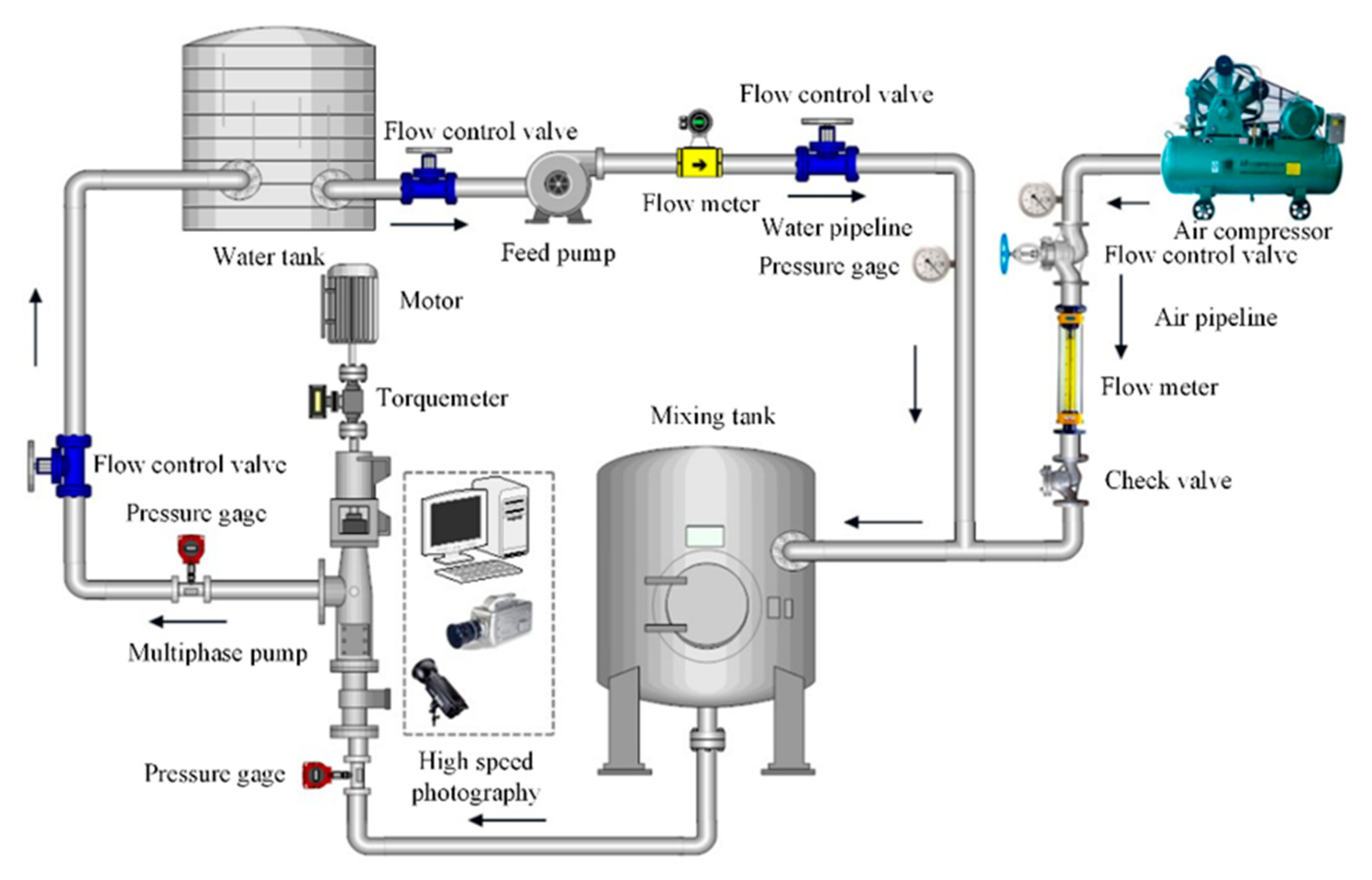
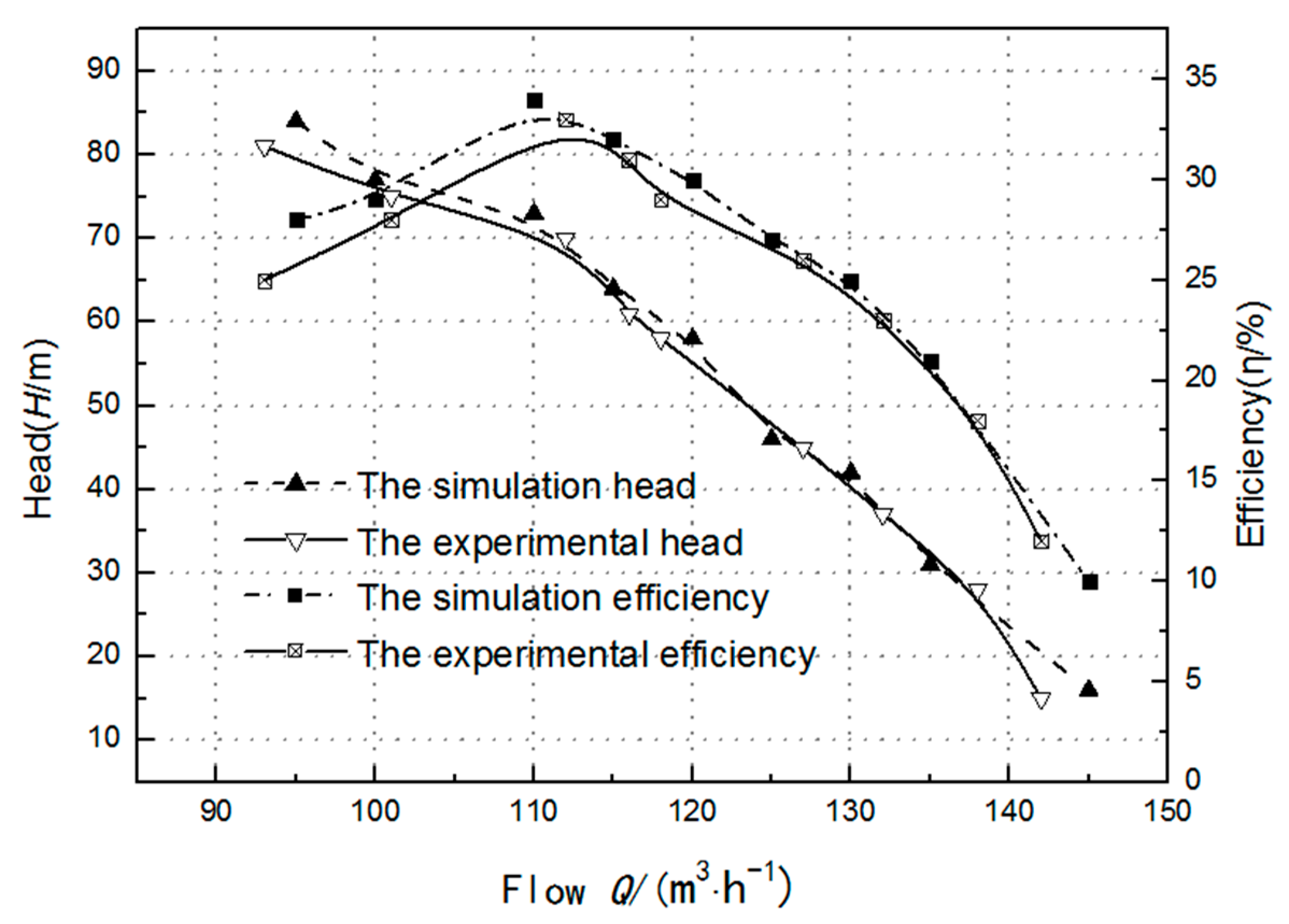
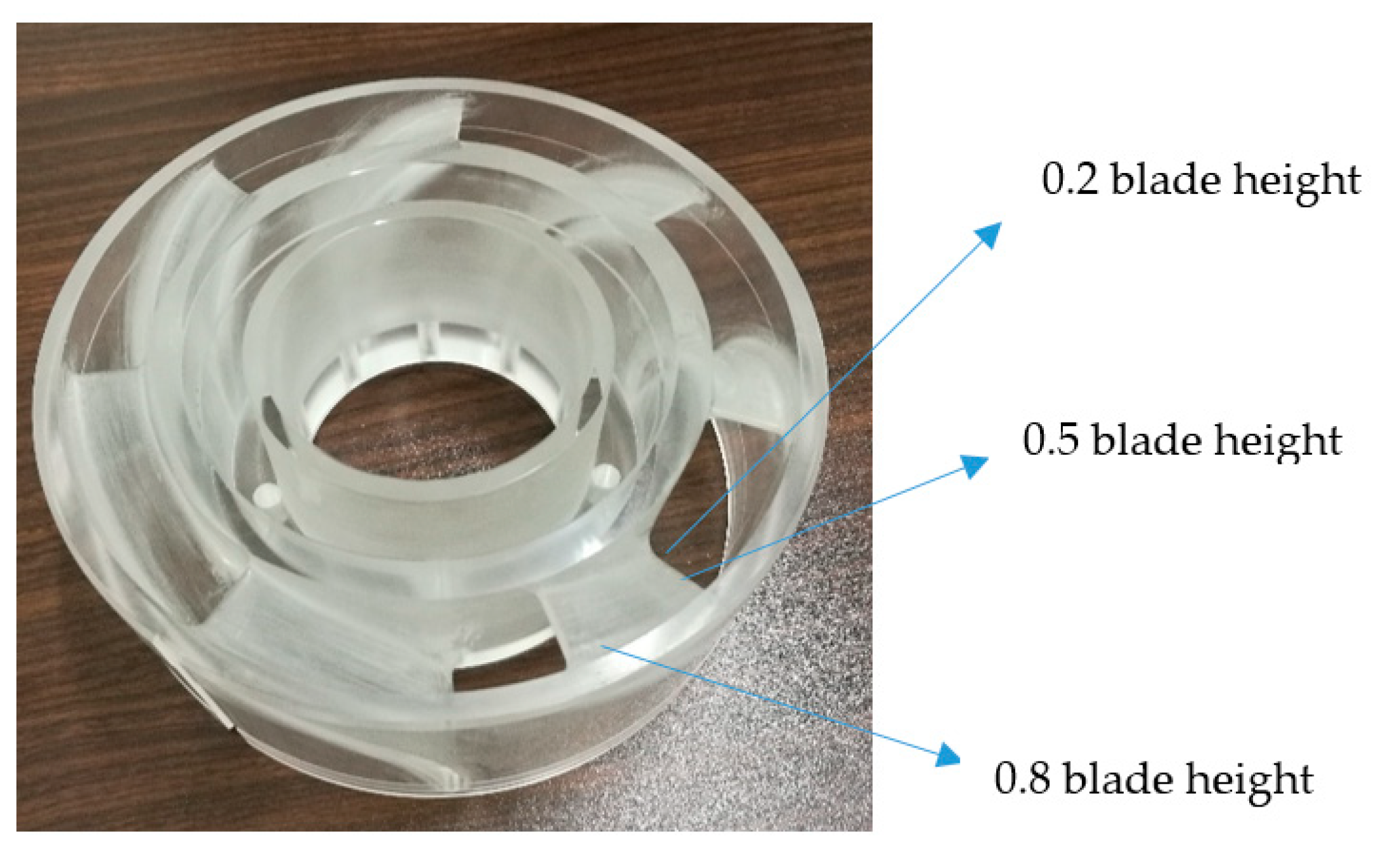

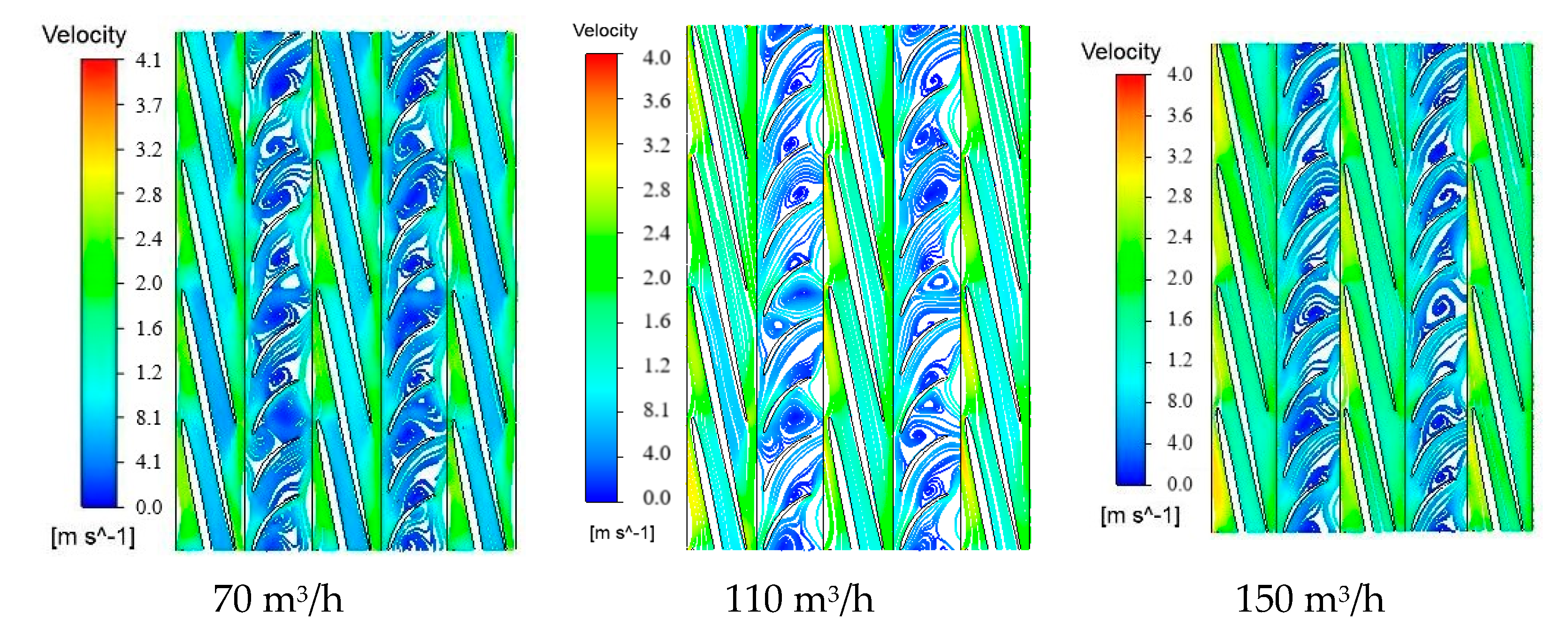
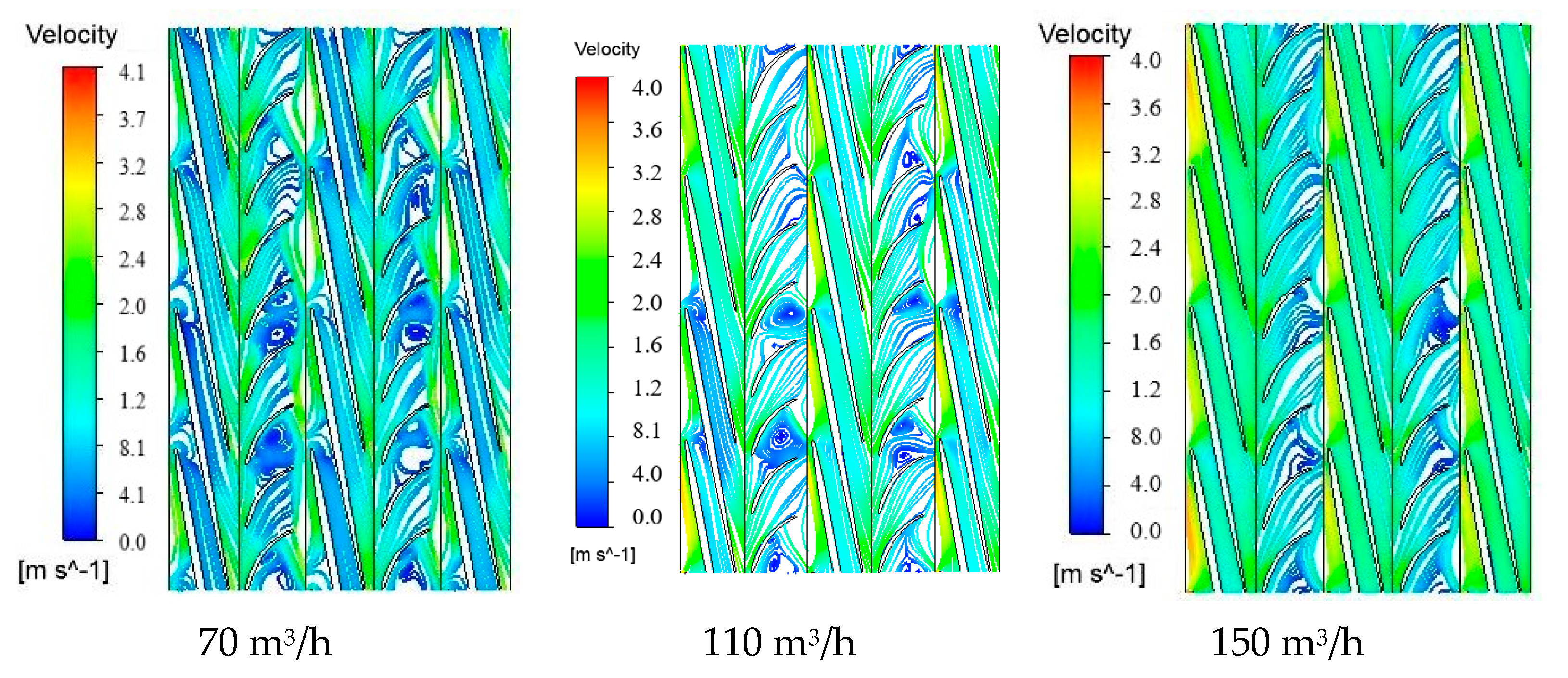
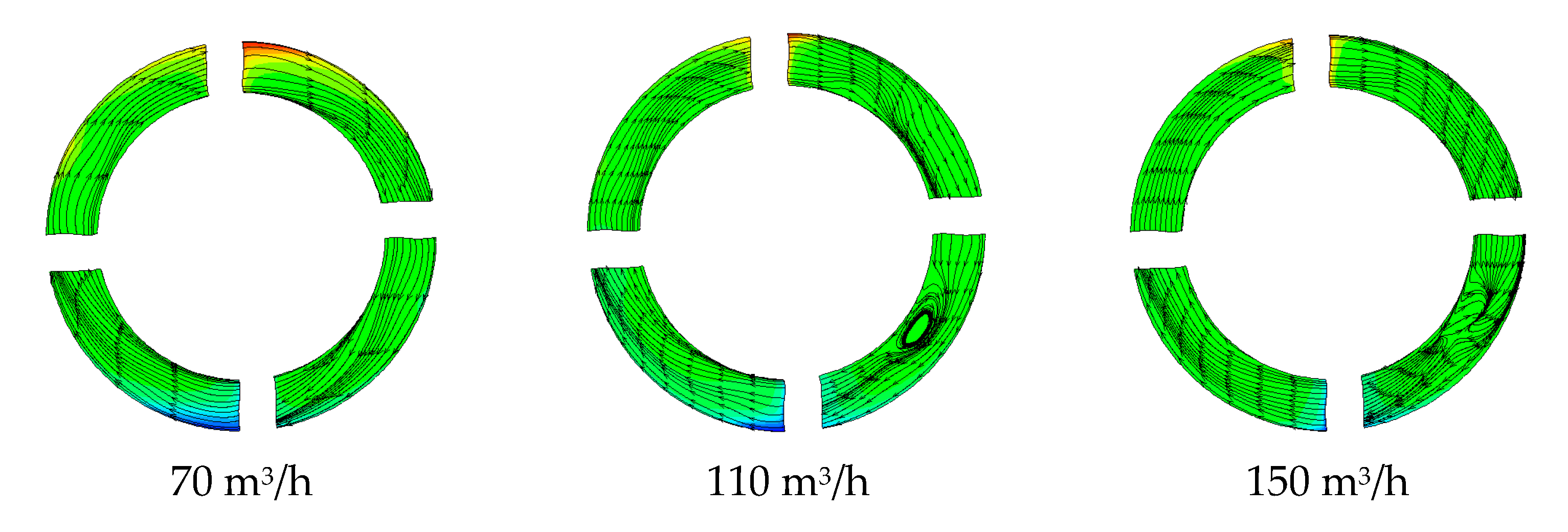





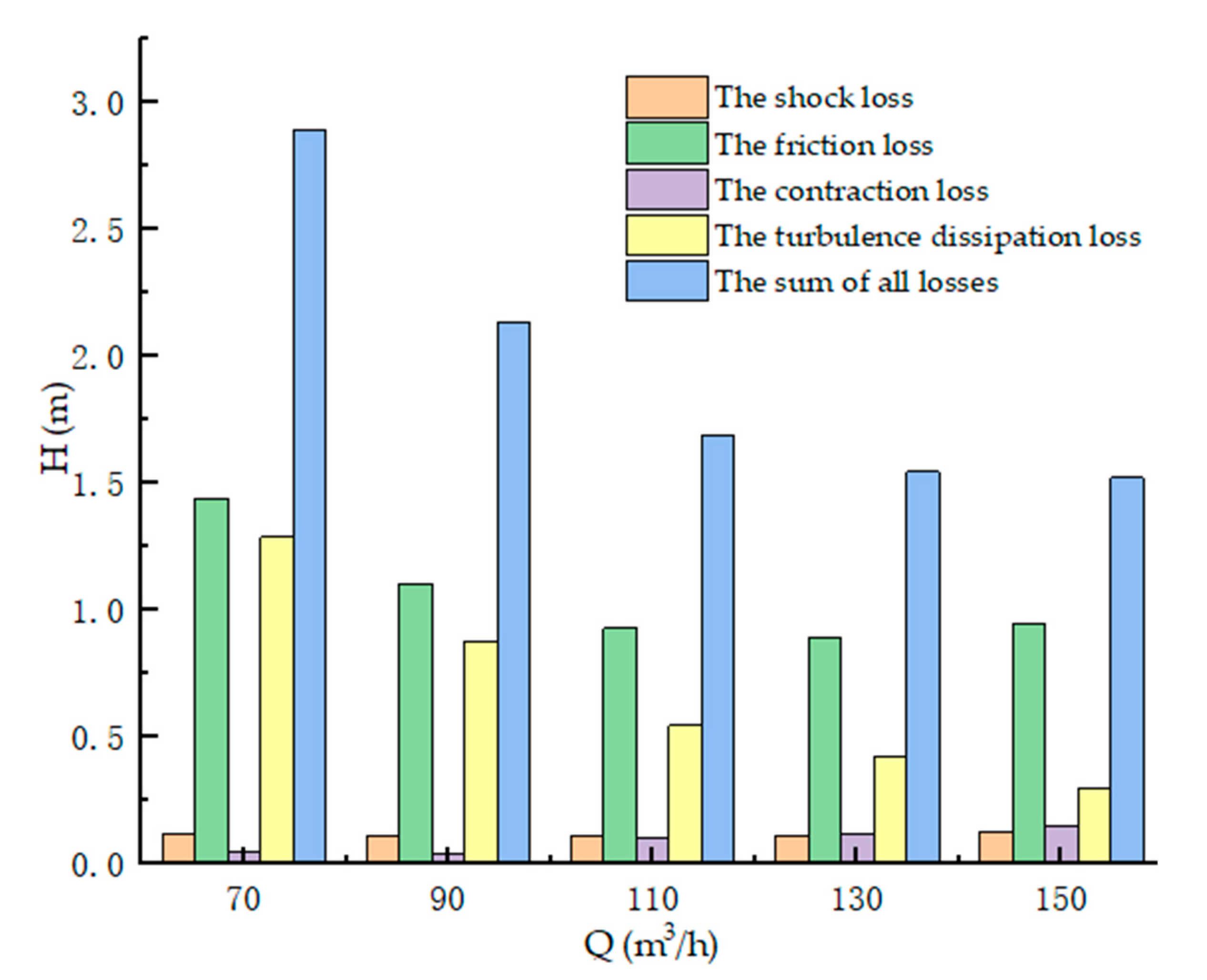

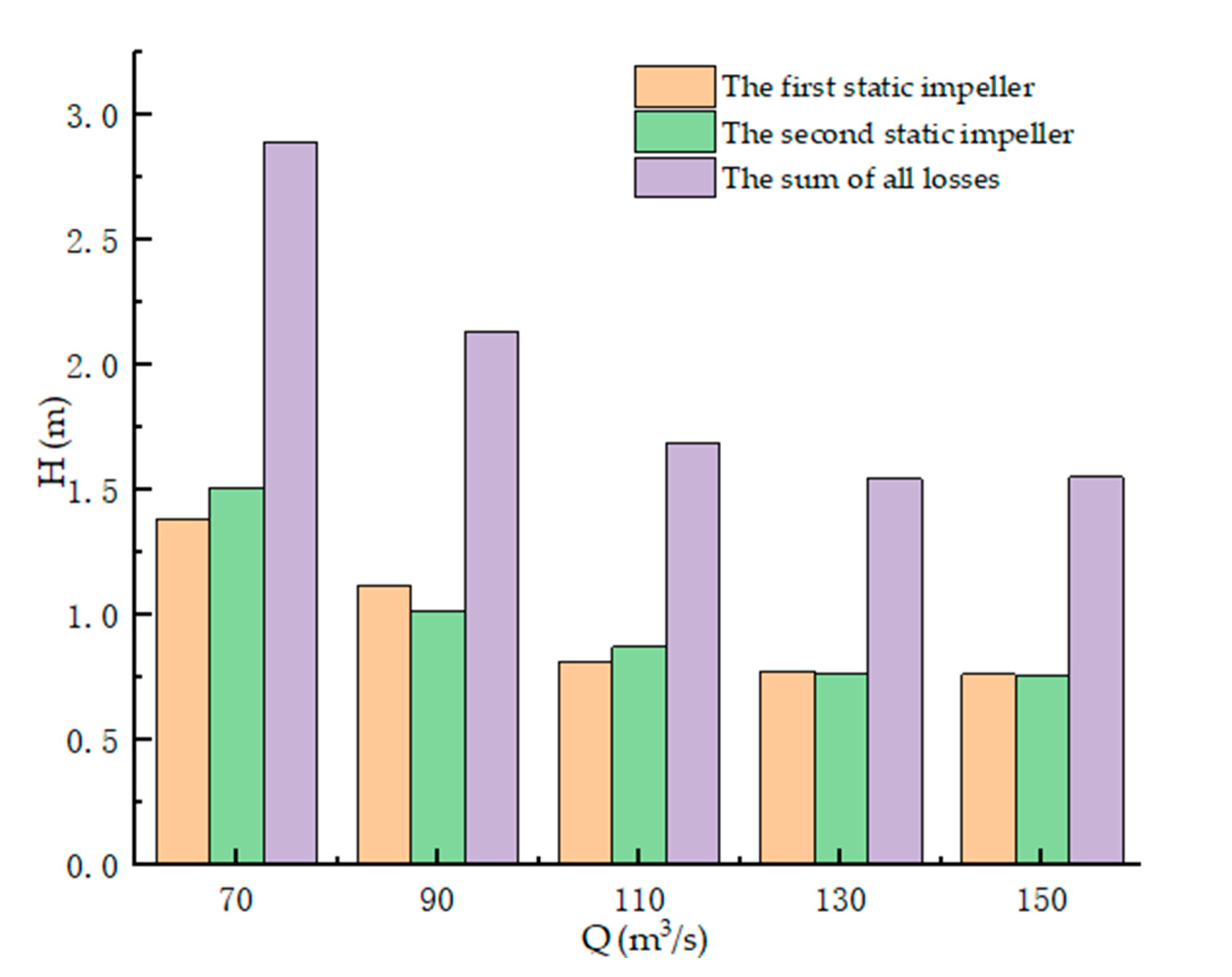
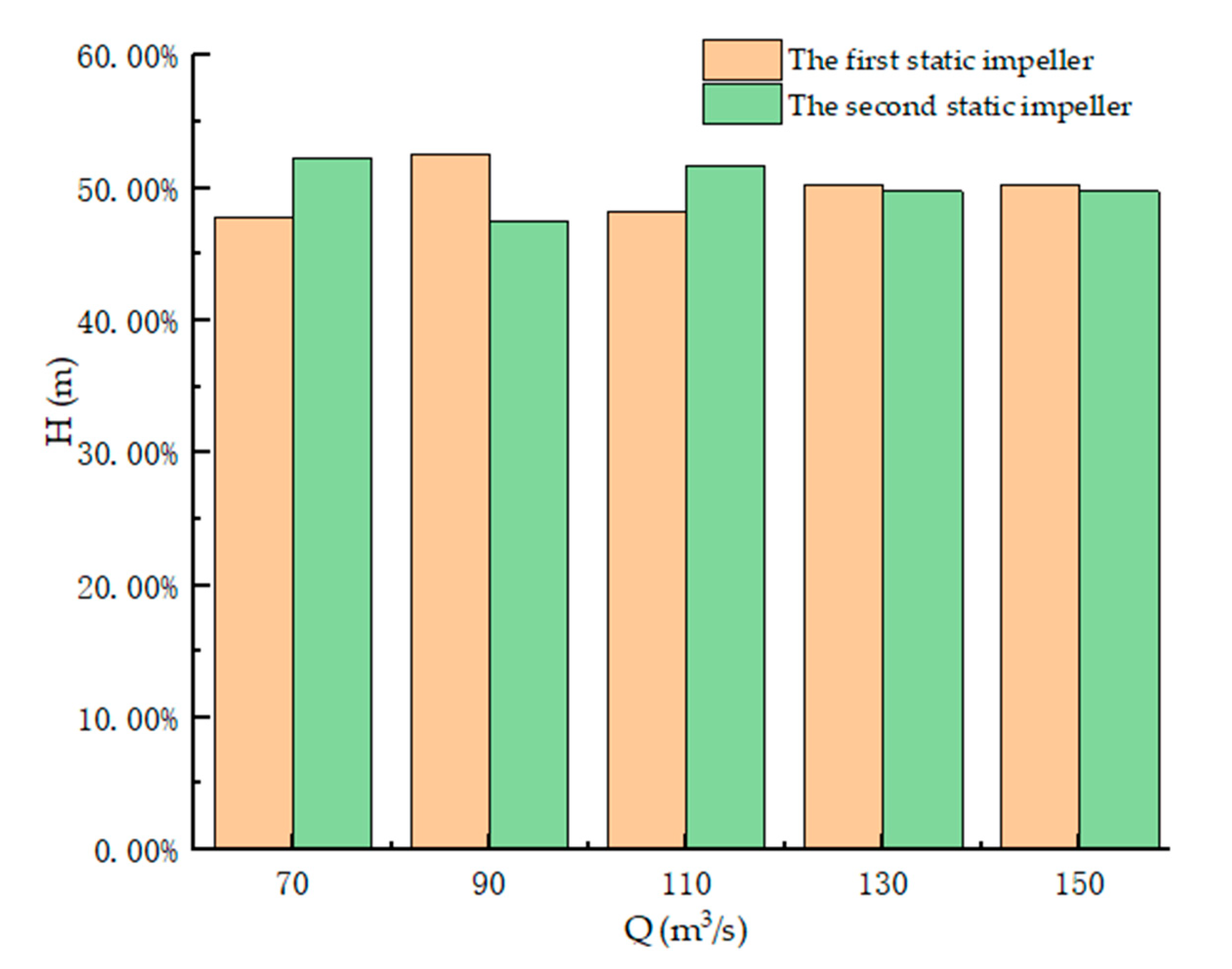

| Parameter | Numerical Value |
|---|---|
| Flow rate | 110 |
| Head | 85 |
| Design rotate speed | 3000 |
| Stage | 6 |
Publisher’s Note: MDPI stays neutral with regard to jurisdictional claims in published maps and institutional affiliations. |
© 2021 by the authors. Licensee MDPI, Basel, Switzerland. This article is an open access article distributed under the terms and conditions of the Creative Commons Attribution (CC BY) license (https://creativecommons.org/licenses/by/4.0/).
Share and Cite
Jiang, Z.; Li, H.; Shi, G.; Liu, X. Flow Characteristics and Energy Loss within the Static Impeller of Multiphase Pump. Processes 2021, 9, 1025. https://doi.org/10.3390/pr9061025
Jiang Z, Li H, Shi G, Liu X. Flow Characteristics and Energy Loss within the Static Impeller of Multiphase Pump. Processes. 2021; 9(6):1025. https://doi.org/10.3390/pr9061025
Chicago/Turabian StyleJiang, Zhu, Haiying Li, Guangtai Shi, and Xiaobing Liu. 2021. "Flow Characteristics and Energy Loss within the Static Impeller of Multiphase Pump" Processes 9, no. 6: 1025. https://doi.org/10.3390/pr9061025





